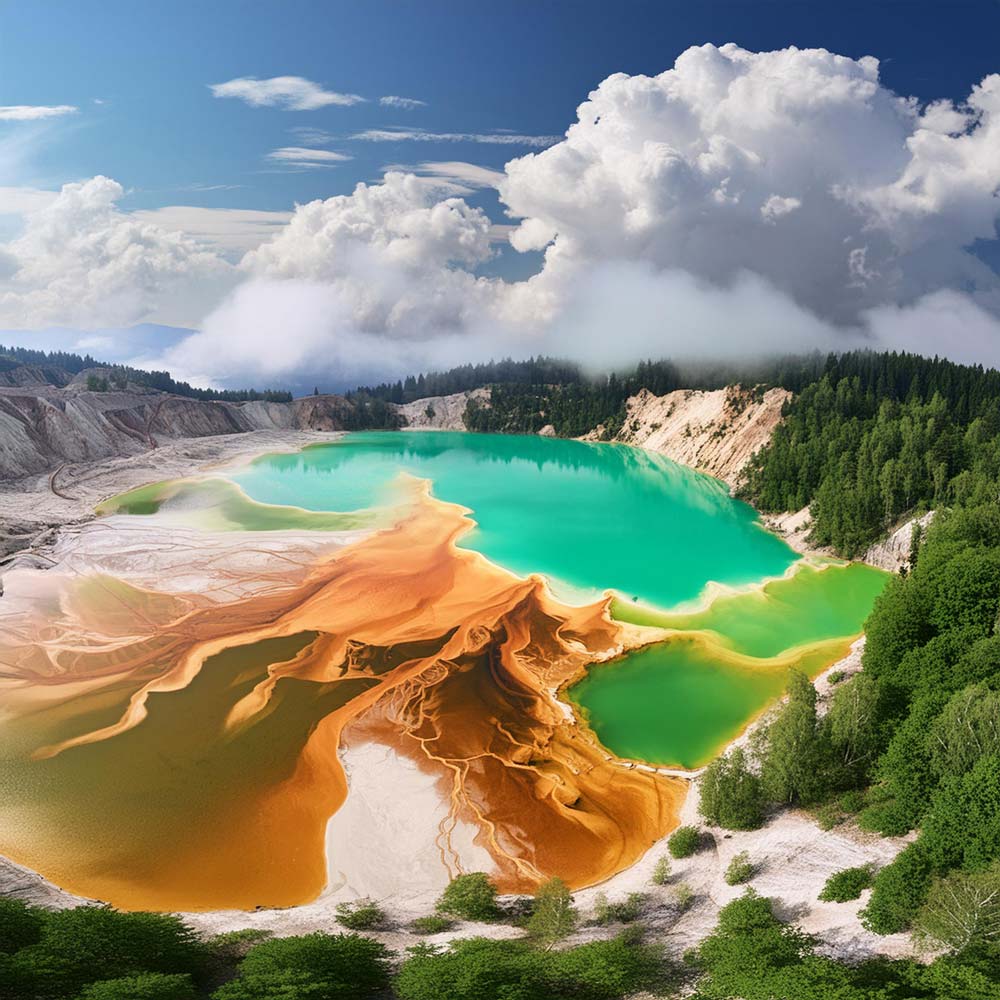Nestled in the picturesque Apuseni Mountains of Transylvania, Romania, lies Geamana Lake, an eerie reminder of industrial exploitation and environmental neglect. Unlike the region’s more famous scenic spots, this lake is not known for its beauty or recreational opportunities. Instead, it tells a haunting story of a village sacrificed for copper extraction, leaving behind a toxic legacy that continues to affect the environment and local communities. This article dives into the history, impact, and ongoing challenges posed by Geamana Lake, providing a comprehensive understanding of this environmental disaster.
The Birth of Geamana Lake
Geamana Lake’s creation dates back to the late 1970s when the Romanian government, under Nicolae Ceaușescu’s regime, prioritized industrial development over environmental and social considerations. The Rosia Poieni copper mine, one of Europe’s largest, was established to exploit the region’s rich copper reserves. However, the extraction process produced massive amounts of toxic waste, including heavy metals and chemical byproducts.
To accommodate this waste, the government decided to create a tailings pond, effectively converting the village of Geamana into a dumping ground. Residents were forcibly relocated, and their homes, farmlands, and even the local cemetery were submerged under a toxic slurry of mining waste. By the early 1980s, Geamana Lake had begun to take shape, rapidly expanding as more waste was deposited.
The Toxic Composition
Geamana Lake is not a natural body of water but a man-made basin filled with tailings from the Rosia Poieni mine. The tailings are a mixture of water, finely ground rock particles, and various chemicals used in the copper extraction process. Among the most concerning components are:
Heavy Metals: The lake contains high concentrations of heavy metals such as copper, zinc, lead, and cadmium. These metals are toxic to both aquatic life and humans, posing long-term health risks.
Acids: Sulfuric acid, a byproduct of the mining process, is present in the lake, contributing to its high acidity levels. Acidic conditions can lead to the leaching of heavy metals into the surrounding environment, further contaminating soil and groundwater.
Chemical Reagents: Various chemicals used in the flotation process to separate copper from ore are also present in the lake. These include xanthates, cyanides, and other reagents that are harmful to the environment and living organisms.
Environmental Impact
The environmental impact of Geamana Lake is profound and far-reaching. The lake’s toxic waters have infiltrated the surrounding landscape, contaminating soil, groundwater, and nearby rivers. The once-thriving ecosystems of the region have been severely disrupted, with the loss of biodiversity being one of the most visible consequences.
Water Contamination: The lake’s acidic and metal-laden waters have seeped into local water sources, making them unsafe for consumption by humans and animals. This contamination has also affected agricultural activities, as the toxic water renders soil infertile and crops unsafe to eat.
Loss of Biodiversity: The creation of Geamana Lake led to the destruction of local habitats, resulting in a significant loss of plant and animal species. Aquatic life, in particular, has been severely impacted, with the toxic waters proving lethal to fish and other organisms.
Soil Degradation: The deposition of heavy metals and acids in the soil has led to long-term degradation, making it difficult for vegetation to grow. This has resulted in barren landscapes that are prone to erosion and further environmental degradation.
Social and Health Implications
The forced relocation of Geamana’s residents was a traumatic experience, disrupting the social fabric of the community and leaving lasting scars. Many of the displaced residents were moved to nearby towns and villages, where they struggled to rebuild their lives. The loss of their homes, land, and livelihoods had profound social and psychological effects.
Health Risks: Prolonged exposure to heavy metals and toxic chemicals poses serious health risks to the local population. These include respiratory problems, skin conditions, and an increased risk of cancer. Children and pregnant women are particularly vulnerable to these hazards.
Economic Hardship: The loss of agricultural land and the decline in local fisheries have led to economic hardship for many families. The inability to farm or fish has forced some residents to seek work in distant towns or turn to low-paying, informal jobs.
Cultural Loss: The submersion of Geamana also meant the loss of cultural heritage, including historical buildings, religious sites, and local traditions. The village’s cemetery, containing the graves of generations of residents, was also submerged, adding to the emotional toll on the displaced community.
Current State and Challenges
Today, Geamana Lake continues to expand as the Rosia Poieni mine remains operational. The lake has become a symbol of environmental neglect, with its vivid, unnatural colors drawing occasional media attention but little effective action. Several key challenges hinder efforts to address the lake’s toxic legacy:
Ongoing Contamination: As long as the Rosia Poieni mine remains active, the flow of toxic waste into Geamana Lake will continue. Effective containment and remediation measures are urgently needed to prevent further environmental degradation.
Lack of Resources: Addressing the environmental and social impacts of Geamana Lake requires significant financial and technical resources. However, funding for remediation projects is often limited, and the political will to prioritize these issues is lacking.
Public Awareness: Raising awareness about the plight of Geamana and its residents is crucial for mobilizing support and action. However, the issue has not received the sustained attention it deserves, both within Romania and internationally.
Efforts and Solutions
Despite the daunting challenges, there are potential solutions and ongoing efforts to mitigate the impact of Geamana Lake:
Remediation Projects: Environmental organizations and researchers have proposed various remediation strategies, including the treatment of contaminated water, soil stabilization, and the introduction of vegetation to prevent erosion. Pilot projects and studies are needed to identify the most effective approaches.
Government Action: The Romanian government has a critical role to play in addressing the legacy of Geamana Lake. This includes enforcing stricter environmental regulations on mining operations, allocating funds for remediation, and supporting affected communities.
Community Involvement: Engaging local communities in remediation efforts is essential for ensuring their success. This includes involving residents in decision-making processes, providing them with the necessary resources and training, and addressing their health and economic needs.
International Support: Given the scale of the problem, international support and collaboration are vital. This can include technical assistance, funding, and sharing best practices from other countries that have dealt with similar environmental disasters.
Geamana Lake stands as a stark reminder of the environmental and social costs of unchecked industrial development. The toxic legacy of the Rosia Poieni mine continues to impact the region, posing ongoing challenges for both the environment and local communities. Addressing these challenges requires concerted efforts from the government, environmental organizations, researchers, and the affected communities themselves. By raising awareness and mobilizing resources, it is possible to mitigate the damage and work towards a more sustainable future for the region.

